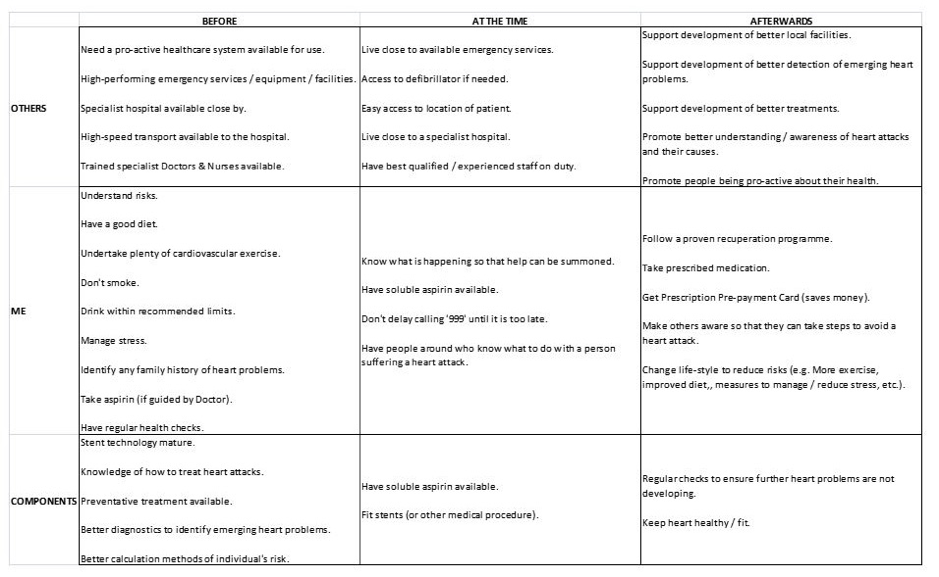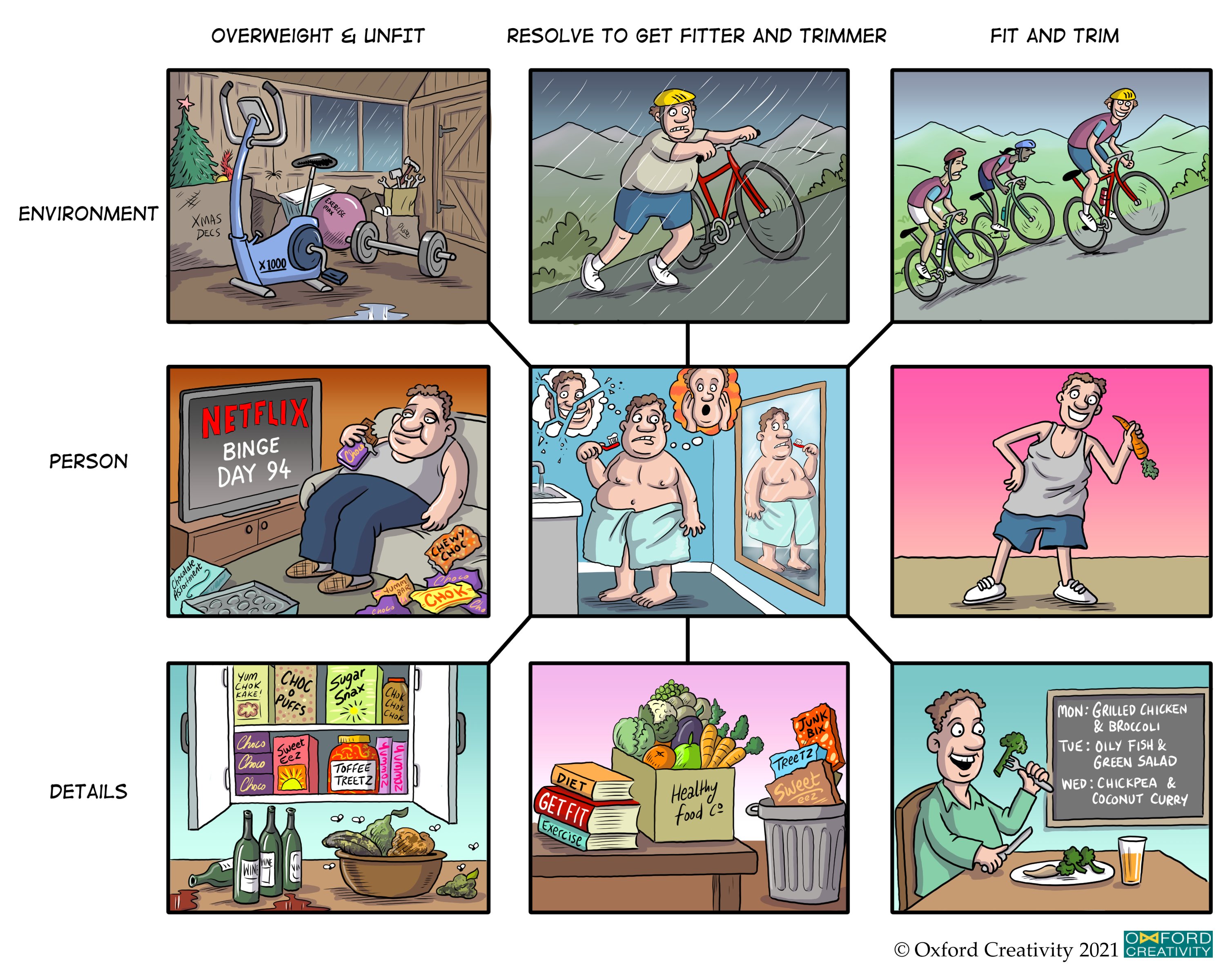When Keith Rigby had a heart attack he knew he needed to change his lifestyle to reduce the risk of having another one. Keith had been using TRIZ in his day job for many years, so he decided to use TRIZ to take a structured approach to improving his lifestyle and keeping himself healthy for years to come.
I had a heart attack!
A heart attack wasn’t something I was expecting and when you look at all the risk factors which could lead to such an event, I was deemed to be a low risk [1] . This wasn’t just my view, but the view of health professionals, I had:
- Low Cholesterol
- Not Overweight
- A Healthy Diet
- Not a Heavy Drinker
- Never Smoked
But, my blood pressure was always towards the high end of acceptable, I knew I should have been doing more exercise; and I had relatives who have suffered heart problems in the past.
Two days after my heart attack and I am lying in a hospital bed thinking about what low risk actually means. I am a Systems Engineer working in the defence industry where safety and risk is an essential part of what we do. We view risk from two viewpoints:
- The Severity of the Consequences
- The Likelihood of it Happening

Figure 1: Hazard Risk Index - a typical assessment of how we apportion and manage risk.
In my engineering world, the severity of the consequences of a heart attack would be classed as ‘Catastrophic’ - could result in death, permanent total disability, total system loss or irreversible severe environmental damage.
With regards to the probability of occurrence, this is a little more subjective.
If I assume that on average, a person can live to be 80 years old, this equates to just over 700,000 hours. Ideally, I would want my risk of suffering a heart attack to be one chance in significantly more than 700,000 hours. When I compare life expectancy in hours to the probability of occurrence in my engineering world, it equates to ‘Remote’ - defined as unlikely, but can reasonably be expected to occur during the life of the system. This means it could occur greater than once every 1 million hours.

By referring to Figure 1, we see that this equates to a ‘moderate hazard risk’ - a catastrophic event which has a remote probability of occurrence. Which in my engineering world would have to be reviewed and wherever practicable, action should be taken to improve the situation. We must look at what can be done to make the probability of occurrence ‘Improbable’ - defined as unlikely to occur during the life of the system, but possible.
This simplified analysis actually contains a very important lesson for us all.
When it comes to looking after your heart, you always need to do more to reduce your risk, even when you are deemed to be at low risk.
Having suffered a heart attack, it has been a major wake-up call for me.
During my convalescence, I was initially limited to what I could do physically, but I was allowed to read and to think. And I started to think about applying TRIZ to my problem. If you have not come across TRIZ before, it is a set of tools used for analysing and solving any problem. [2]
I have used it in my engineering career and it works!
But for this exercise (albeit, initially an academic exercise to see how TRIZ could be used on a non-engineering problem), it was to give me a process for developing how I could change my life in the future.
For the purposes of this article, I have summarised the tools I used understanding my problem and the solutions I have devised. But hopefully there is enough in the following to give you a flavour of how to start using TRIZ [3] and how it can really help in any situation.
What if I had done this exercise before I had my heart attack? The obvious place to start would have been with the TRIZ 9-boxes of ‘Thinking in Time and Scale’.
In about 20 minutes I had drawn Figure 2.

Figure 2: 9-Box Thinking in Time & Scale
You may say that there is nothing in these 9-boxes which is a surprise, but that is not the point. From this, I was able to start to pull together a 'Bad Solution Park’ for what I could have done (and others should maybe consider doing now) and things I could do in the future.

My next step was to consider the fundamental principle of TRIZ and that is to define my ‘Ideal Outcome’. Not surprisingly, this was quite simple – ‘Don’t have another heart attack’.
From this simple premise, I was then able to develop a list of ‘Benefits’, ‘Costs’ and ‘Harms’ as follows:
BENEFITS:
- Live longer
- Be around for my family
- Available to enjoy life to the full
- Be around for my children and to see them through education and into their lives as independent people
- My wife is not widowed
- Be around to do the things I haven’t done yet
- Can educate others to avoid heart attacks
COSTS:
- Need to find time to pro-actively look after my health
- Need money to do what I want to do
- Need time to do what I want to do
- Healthier life-style costs more (improved diet, gym membership, etc).
HARMS:
- What I want to do may not be what my wife and family wants to do
- Family commitments mean that I am not totally free to do what I want to do
- I still have a mortgage to pay, so some benefits may not be achievable yet
From the above and the 9-Box analysis, I very quickly developed 33 ideas and captured them on my ‘Bad Solution Park’.
The whole exercise took me less than 90 minutes, showing how quick TRIZ can be to analyse a problem and to start to develop some initial solutions.
But this is only the start of the story. TRIZ has many tools which will help me to further develop my initial solutions, to look at how I can turn the ‘Harms’ into ‘Benefits’, whilst reducing ‘Costs’ and to determine which solutions I am actually going to implement in my life.

The ‘Harms’ particularly suggest that there are ‘Contradictions’ (TRIZ has a method for creatively solving contradictions) and the ideas developed from the 9-Box give me new avenues to pursue. I have categorised my ‘Bad solutions’ into the following themes:
This now allows me to focus my TRIZ thinking in specific areas and to combine where possible, my ‘bad solutions’ into a more manageable number.
I am not sure where this journey is now going to take me, but as you can see, the quick and simple application of a few TRIZ tools has given me a greater scope than if I had just returned to health and then continued my life from where it left off.
I think it is definitely a case that TRIZ will change my life.
To learn the TRIZ tools that Keith used to develop his lifestyle improvement plan, sign up to our next Fundamental Problem Solving training:
FOOTNOTE REFERENCES
[1] To calculate your risk see for example, www.riskscore.org.uk/ - my risk was calculated as 1.18% chance of having a heart attack in the next 5 years. But I still had a heart attack.
[2] TRIZ: Teoriya Resheniya Izobretatelskikh Zadatch – Theory of Inventive Problem Solving.
[3] For more information on TRIZ see 'What is TRIZ?"
This article was originally published in March 2017.





